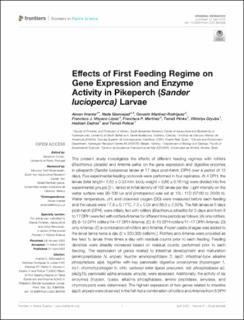| dc.description.abstract | The present study investigates the effects of different feeding regimes with rotifers (Brachionus plicatilis) and Artemia salina on the gene expression and digestive enzymes in pikeperch (Sander lucioperca) larvae at 17 days post-hatch (DPH) over a period of 13 days. Five experimental feeding protocols were performed in four replicates. At 4 DPH, the larvae (total length= 5.62 ± 0.03 mm, body weight = 0.66 ± 0.16 mg) were divided into five experimental groups (2-L tanks) at initial density of 100 larvae per liter. Light intensity on the water surface was 90-100 lux and photoperiod was set at 13L: 11D (07:00 to 20:00 h). Water temperature, pH, and dissolved oxygen (DO) were measured before each feeding and the values were 17.8 ± 0.17°C, 7.3 ± 0.04 and 88.5 ± 2.53%. The fish larvae at 5 days post-hatch (DPH), were initially fed with rotifers (Brachionus plicatilis) for 3 days and from 8 to 17 DPH were fed with rotifers/Artemia for different time periods as follows: (A) only rotifers; (B) 8–13 DPH rotifers/14–17 DPH Artemia; (C) 8–10 DPH rotifers/11–17 DPH Artemia; (D) only Artemia; (E) a combination of rotifers and Artemia. Frozen paste of algae was added to the larval tanks twice a day (2 x 300,000 cells/mL). Rotifers and Artemia were provided as live feed to larvae three times a day with residual counts prior to each feeding. Feeding densities were steadily increased based on residual counts, performed prior to each feeding. The expression of genes related to intestinal development and maturation (aminopeptidase N, anpep; leucine aminopeptidase 3, lap3; intestinal-type alkaline phosphatase, alpi), together with key pancreatic digestive proenzymes (trypsinogen 1, try1; chymotrypsinogen b, ctrb; carboxyl ester lipase precursor, cel; phospholipase a2, pla2g1b; pancreatic alpha amylase, amy2a), were assessed. Additionally, the activity of six enzymes (trypsin, lipase, alkaline phosphatase, amino peptidase, amylase, and chymotrypsin) were determined. The highest expression of two genes related to intestine (lap3; anpep) were observed in the fish fed a combination of rotifers and Artemia from 8 DPH (Group E). The expression of amy2a, ctrb, pla2g1b, try1 was significantly lower in larvae fed rotifers until 14 DPH and replaced by Artemia afterwards (Group B). The specific activity of brush border membrane enzymes (alkaline phosphatase and aminopeptidase N) increased with combination of rotifers and Artemia in larval diet (Group E), indicating a more efficient functionality of digestive structures. The groups fed only with rotifers till 17 DPH (Group A) (38 ± 4.07%) and larvae fed with rotifers till 14 DPH followed by feeding with Artemia till 17 DPH (Group B) (36 ± 5.25%) showed significantly (P<0.05) lower survival rates than the other groups (54-67%). The group fed only with rotifers (Group A) showed significantly lower specific growth rate (SGR) than the other groups, and the highest SGR was found in the group fed with combination of rotifers and Artemia after 3 day rotifer feeding (Group E). The highest standard length (8.32 ± 0.48 mm) was obtained by combined feeding of rotifers and Artemia after 3 day of initial rotifer feeding. Combination of rotifers and Artemia from 8 DPH (Group E) could be considered a more appropriate diet for first feeding pikeperch larvae compared with later introduction of Artemia, as indicated by the higher expression of genes and activities of digestive enzymes. Our findings provide new insight into the effect of temporal sequence of rotifers and Artemia on the expression of genes and activities of digestive enzymes in pikeperch larvae. | en_US |

